Breast Reduction
Too Big ... No Problem ... Minimize

Breast Reduction, also known as "Reduction Mammoplasty", or "Reduction
Mammaplasty", is the plastic surgery procedure for reducing the size of large breasts.
Large, pendulous breasts may cause a woman to potentially experience various medical problems caused by the excessive
weight of the breast tissue. Medical problems commonly associated with this condition might include: skeletal
deformities, back and neck pain, posture changes, skin irritations and breathing problems. Bra straps often leave
indentations in the shoulder area. These issues may affect a woman or young girls's emotional state or confidence.
Breast reduction removes fat, glandular tissue, and excessive skin, resulting in smaller, lighter and firmer breasts
that are better-shaped in proportion to rest of the body. However, changing the appearance of the breasts is not the
only outcome of the procedure. It also improves function by liberating movement and possibly alleviating pain.
This procedure is usually performed on fully developed adult women, but in certain cases may be perfomred on teenagers
when physical discomfort is a concern. Breast reduction patients frequently express they wish they had the procedure
done sooner because they are so pleased with the outcome.
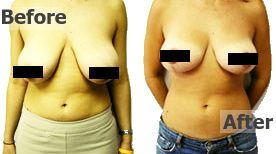
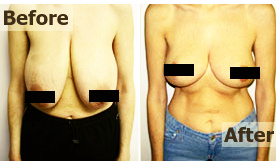
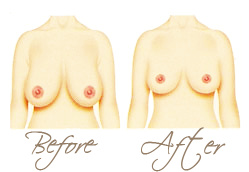
Physical, Aesthetic & Psychological
As oversized breasts are generally combined with drooping breasts (mastoptosis), they look ugly and can cause pain in
the shoulders, neck, etc. due to their weight. In addition, people often suffer from a skin lesion such as eczema, etc.
on the infra-mammary fold or around the area (caused by many skin folds) between breasts and personal hygiene often
becomes a problem.
Sensitive female adolescents are often emotionally distressed by the eyes of others and can suffer from social phobia
and an emotional disorder in more serious cases.
When To Consider Breast Reduction:
- Your Breasts Are Fully Developed
- If Your Breasts Are Too Large For Your Body Frame
(Create Neck, Back, or Shoulder Pain) - One Breast is Larger Than The Other
- Heavy Breasts With Nipples & Areolas That Point Downward
(Pigmented Skin Surrounding The Nipples) - If You Are Unhappy & Self-Conscious About The Large Appearance of Your Breasts

In some cases it is done along with plastic surgery procedures such as:
- Facelift
- Liposuction
- Tummy Tuck
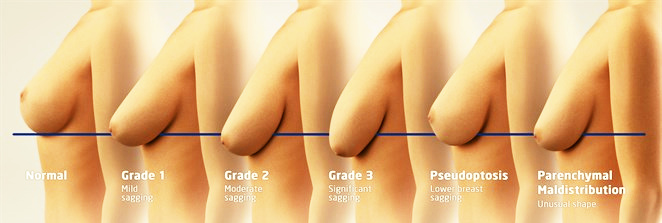
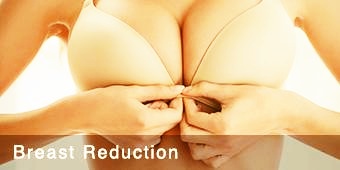
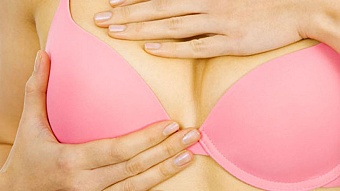
Advantages of Breast Reduction
- Firmer Breasts Which Are More Proportionate To Your Body
- Getting Rid of The Continuous Neck, Back & Shoulder Pain
- Feeling More Confident About Your Appearance
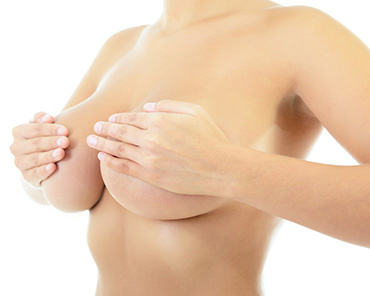
Disadvantages of Breast Reduction
- You May Have Decreased Sensation In Some Areas
(Including The Nipples & Areolas) - Some Women Complain That Their Breasts & Nipples Look Slightly Uneven
- Breast-Feeding May Be a Problem

Surgery Overview
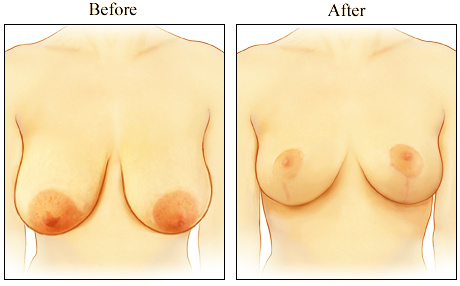
Breast Reduction Surgery (Reduction Mammoplasty) removes some of the tissue and skin from the breasts to reshape and reduce the size of the breasts. It can also make the area of dark skin surrounding the nipple (Areola) smaller.
To remove tissue and skin from the breast, the surgeon first makes one or more cuts in the breast. After the excess tissue and skin have been removed, the skin is closed with stitches. Sometimes the nipple and areola have to be removed and repositioned.

Sometimes liposuction is used along with surgery. If most of the breast is fatty tissue and if excess skin isn't a problem, liposuction alone may be enough for breast reduction.
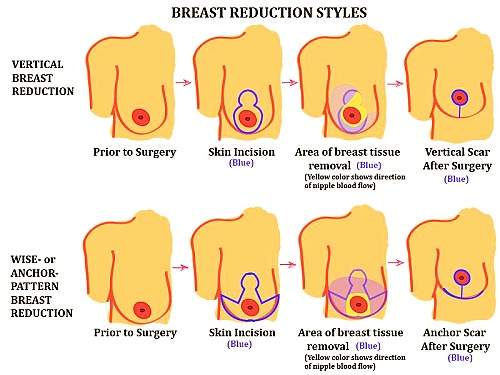
Breast Lift
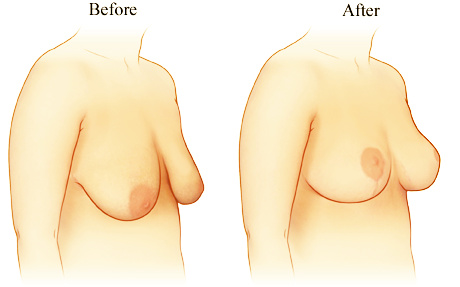
Breast Lift (Mastopexy) is similar to a breast reduction, except that in some cases only skin is removed.
A breast lift can raise sagging or drooping breasts, which is a common problem with large, heavy breasts, and can elevate the nipple and areola.
- Feel more comfortable. Large, heavy breasts can cause back and neck pain, skin irritation, and posture problems. The constant pull of heavy breasts may make bra straps leave painful indentations in a woman's shoulders. Breast reduction surgery can eliminate these problems in most cases.
- Reduce the limitations that large, heavy breasts place on participation in sports or other activities. Some physical activities may be painful or awkward for women who have large breasts.
- Alter your appearance. Large breasts, especially when they are out of proportion to your height and weight, can be embarrassing. Teenagers and young women with large breasts may especially feel self-conscious wearing swimsuits and other types of clothing due to unwelcome attention to large breasts. It also may be hard to find clothes that fit well.
The results of breast reduction surgery are considered permanent. But the breasts may become larger or their shape may change as a result of pregnancy, weight gain, or weight loss.
- Scars. Breast reduction surgery always leaves visible scars on the breasts. But how bad the scars are varies from person to person and by the type of incision. Although red and swollen at first, scars typically fade over time. But scars may remain very noticeable in some women long after surgery. Fortunately, the incisions usually can be limited to areas of the breast that can be covered by a bra.
- Unevenly positioned nipples, or breasts that are not the same size or shape.
- Loss of feeling in the nipples or breasts. This is often temporary, lasting a few months. But in some women it lasts much longer or becomes permanent. Because some women with large breasts do not have a lot of feeling in their breasts before surgery, this may not be a concern.
- Inability to breast-feed after surgery. Some women may still be able to breast-feed, depending on what type of reduction was done.

